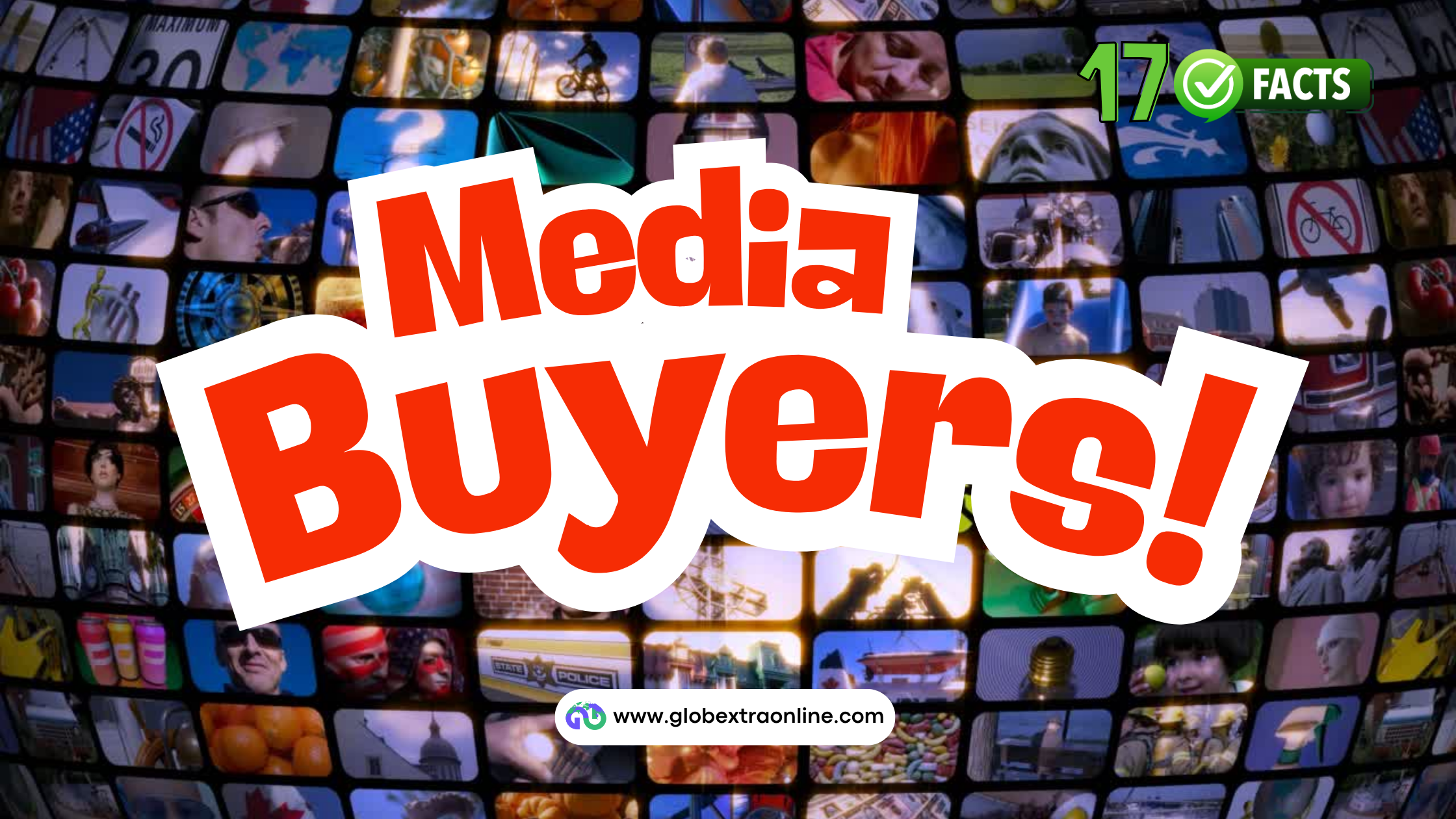In today’s competitive advertising landscape, simply creating great ads isn’t enough—you need to ensure they reach the right audience at the right time. This is where media buyers come in, and if you want to know more about how they can help you scale, read our blog, where we have answered 17 of the most commonly asked questions.
At Globextra, we love content that helps us make an impact on people’s lives, and what better than blogging? So, here we are with another trending topic & we hope you find it informative.
Media Buyers – 17 Questions & Answers Guide That You Need
In today’s digital ad space, media buyers play a crucial role in executing effective advertising strategies by purchasing ad placements across various platforms to maximize visibility and ROI. Whether you’re a business owner, marketer, or aspiring media buyer, this guide answers the most frequently asked questions about media buyers through 17 irrefutable facts. Let us dive into the world of ads.
1. Media Buyers- The Term Defined
A media buyer is responsible for purchasing advertising space across various platforms to ensure brands effectively reach their target audience. They negotiate prices, optimize ad placements, and maximize return on investment (ROI) for paid media campaigns.
2. How Did Media Buying Evolve?
We can trace the history back to the late 1990s, which before the time was generally carried out by the media department of an advertising agency. With the rise of online platforms and programmatic advertising, modern media buying is more automated and targeted than ever before.
3. What Does a Media Buyer Do?
The job role of media buyers is to identify the best channels, negotiate costs, place ads, monitor performance, and optimize campaigns to ensure brands get the best exposure at the lowest cost.
4. Which Platforms Do Media Buyers Use?
Media buyers work across various platforms and some are mentioned below.
- Digital Platforms: Google Ads, Facebook, Instagram, TikTok, YouTube, LinkedIn, Programmatic Ads.
- Traditional Platforms: TV, Radio, Print, Billboards, Magazines.
- Hybrid Platforms: Streaming Services, OTT Platforms.
5. What is Media Buying in Digital Marketing?
Media buying in digital marketing refers to purchasing an ad space on digital channels, leveraging it based on audience data to optimize the right placement, and ensuring cost-effective reach across social media, search engines, and display networks. Want to know more about digital marketing? Read our blog on Digital Marketing and let us 7 important categories guide you.
6. What is the Function of Media Buying?
Media buying ensures ads appear in the right place, at the right time, to the right audience, thus optimizing spending and maximizing the brand’s visibility.
7. How To Start A Career As A Media Buyer?
Starting a career as a media buyer requires a mix of analytical skills, negotiation expertise, and digital marketing knowledge. We have mentioned the steps below and hope they help.
A degree in marketing, advertising, communications, or business can provide a strong base. However, certifications in digital advertising (Google Ads, Facebook Blueprint, etc.) are equally valuable and will help you land a job.
- Gain experience working on budgets, performance metrics, and bidding strategies. Learning how to analyze data and optimize campaigns is essential.
- Get hands-on experience with platforms like Google Ads, Facebook Ads Manager, programmatic buying software, and traditional media networks. Practical knowledge always helps.
- Start with small ad campaigns to understand audience targeting, bidding strategies, and performance tracking before managing larger budgets.
- Connect with industry professionals, attend marketing conferences, and stay updated with advertising trends and algorithm changes.
- Look for job opportunities as a media assistant, digital marketing coordinator, or paid media intern to gain real-world experience before calling yourself as a media buyer.
- You will need to negotiate ad rates and optimize budget allocations. Practicing these skills can help you stand out.
8. What is CPM in Media Buying?
Cost per mile (CPM) is the cost of 1,000 ad impressions. For instance, if your CPM is $5, it means you’re paying $5 for every 1,000 times your ad is displayed. This is a prime metric in media buying that helps marketers to evaluate the efficiency of their advertising spend.
9. Some Terms That You Should Know When Choosing Media Buyers
Let us understand some terms used at large in the media buying industry.
- ROAS (Return on Ad Spend): Measures the profitability of ad campaigns.
- Flight Dates: Campaign start and end dates.
- Frequency: Average number of times an ad is shown to a user.
- Impressions: Number of times an ad is displayed.
- Net Reach: Unique individuals who have viewed an ad.
- Cost Per Click (CPC): The price paid for each click on an ad.
- Click-Through Rate (CTR): The percentage of users who click on an ad after seeing it.
- Media Mix: This refers to the distribution of time and money allocated to your advertisements across multiple platforms, including TV, radio, print and digital.
- Media Planning: This is the process of selecting the optimal mixture of media outlets for marketing a particular business, product, or service. Media planners use research to identify, analyze, and plan campaigns all while staying within a brand’s budget.
- Net Reach: The number of individual people that a commercial or ad serves to at least one time.
- Rotation: Refers to the distribution of spots or ads across certain days and hours within the flight period.
TV and Radio Media Buying Terms
- Audience Turnover: A radio station’s total audience compared to the average quarter hour audience. Generally, it is the number of times new listeners replace an audience within a daypart.
- Avails: Refers to the availability of unsold units of time available for broadcasters and radio stations to sell to marketers.
- Average Quarter-Hour Persons (AQH): The average number of persons listening to a particular radio station for at least five continuous minutes during a 15 minutes time-span.
- Average Quarter-Hour Rating: An approximation of Average Quarter-Hour Persons represented as a percentage of the measurement population.
- Block Programming: A series of programs with a specific demographic appeal. Placing ads in this programming is perfect for advertising messages that all target the same audience.
- Cost Per Point (CPP): The price of reaching an Average Quarter-Hour Persons audience that is equal to roughly one percent of the people in a demographic group.
- Cume: The number of people who listen to a radio station during a day for at least five continuous minutes.
- Daypart: Radio and television advertisements are divided up into time segments for scheduling purposes. These segments include primetime, daytime, late night, early morning, and total day.
- End Rate: This is the actual rate that an advertiser pays for a set television commercial time after all of the negotiations and discounts.
- Fixed Position: A broadcast or radio spot on a schedule to run at a precise time or to run within a specific program.
- Pre-emption and Pre-emptible: This is a displacement practice replacing a scheduled broadcast or radio spot in favor of another spot, usually due to a higher price.
- Run of Schedule or Run of Site (ROS): In television or radio, ROS is scheduling to run across multiple dayparts and multiple days. Usually Monday-Friday, 6 am-12Midnight. In digital marketing, it refers to running on a website with no preference as to specific pages or times.
- Spot Television: Commercial advertising time that is available for sale or purchase from a local TV station. These spots can be either local or national.
Digital Media Buying Terms
- Ad networks – These are companies that connect marketers with a host of varied websites that want to run their ads.
- Banner ad – A banner ad, also known as a display ad, is an ad displayed on websites that gain revenue by placing ads within their content. The ad consists of a static image or animated visual in a box or rectangle (.jpg, .png, .gif, or HTML5).
- Click Through Rate (CTR) – A term used in digital marketing that refers to the measure of success an advertisement had in getting a user to click back to the website.
- Cost Per Click (CPC) – The cost a marketer pays for each user click on a particular ad. CPC mostly applies to paid search advertising or search engine marketing.
10. What Are the Types of Media Buying?
Let us see some types of media buyers in this section.
- Programmatic: Automated real-time bidding.
- Direct: Negotiating ad placements manually.
- Hybrid: A mix of programmatic and direct.
11. What Are The Advantages Of Media Buying?
Maximized ad reach, Cost efficiency, Precise targeting, Real-time optimization, Improved brand awareness, etc are some merits that can be enjoyed when you choose media buyers.
12. The Disadvantages That Should Be Known
High competition for ad space, Requires expertise, Ad fraud risks, high dependence on algorithms, etc are some dark aspects that should be known.
13. Who Needs Media Buyers?
Businesses, brands, agencies, political campaigns, organizations and anyone in the digital era who is looking to maximize their paid advertising efforts needs the services of media buyers.
14. What Are Some Expert Tips for Media Buying?
Let us see some tips that are backed by the experts and mentioned below.
- Research audience behavior.
- Use A/B testing.
- Monitor ad performance regularly.
- Diversify platforms.
- Optimize for ROI.
15. What Are Effective Media Buying Tactics?
Let us see some tactics that should be followed to gain the maximum growth.
- Retarget previous visitors.
- Geo-targeting for location-based ads.
- Cross-channel marketing for multi-platform reach.
16. Knowing Some Common Names That Media Buyers Are Called By
Digital Ad Buyers, Programmatic Traders, Paid Media Specialists, and Advertising Strategists are some names by which media buyers are also known.
17. Media Buyers & Some Use Cases Worth Knowing
Let us see some use cases where media buyers have been a source of remarkable use.
- Brand awareness campaigns.
- Product launches.
- Event promotions.
- E-commerce advertising.
- Lead generation campaigns.
Media buyers are essential for businesses in today’s digital world to maximize their marketing efforts. Mastering the right strategies can lead to high-impact campaigns with significant returns. If you’re looking to optimize your ad spend and reach the right audience effectively, consider working with professional media buyers.
Want expert guidance on media buyers? Contact us today for a free consultation and take your advertising strategy to the next level! We can be reached through our website.
Happy Brand Building!


Leave a Reply